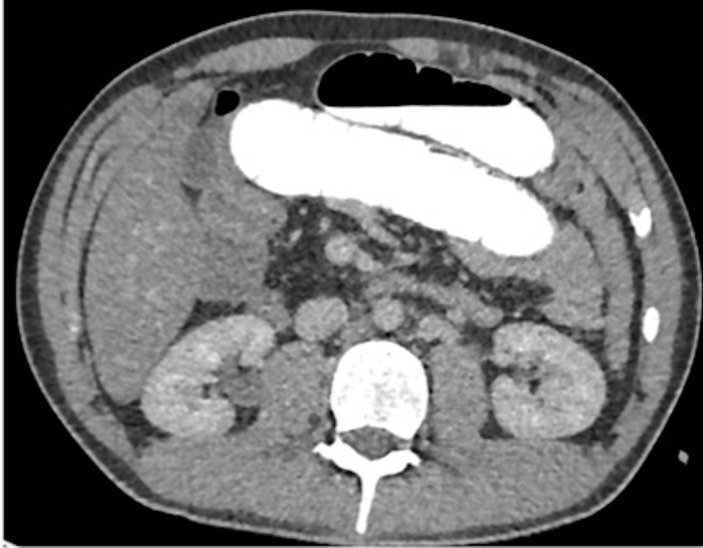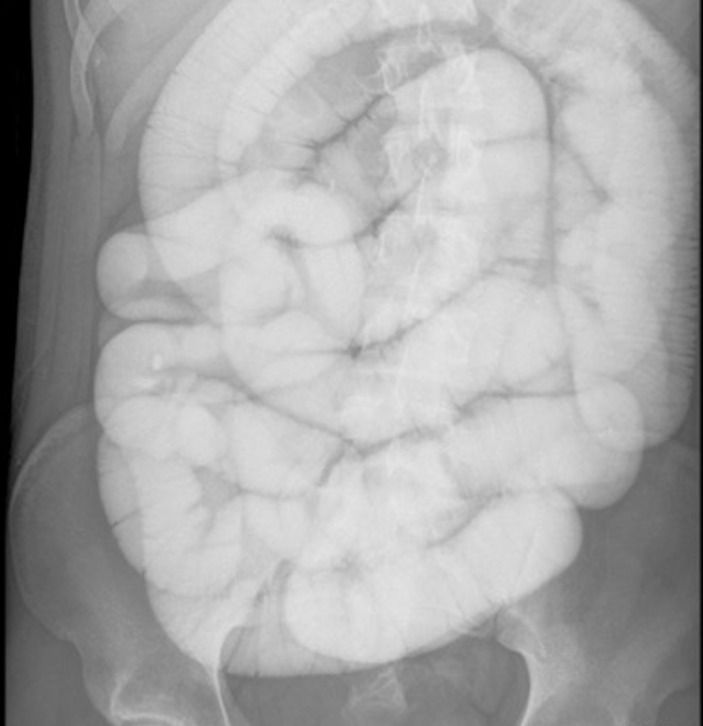Abstract
We describe a case of an 18-year-old man who suffers from cystic fibrosis and developed distal intestinal obstruction syndrome while being treated as an inpatient. Following failed medical management, we proceeded to laparotomy where the small bowel was decompressed with retrograde milking into the stomach, leaving a section of impacted stool in the distal ileum. N-acetylcysteine was injected into the bowel lumen proximal to the obstruction. This resulted in dissolution of the stool without the need for enterotomy and is, to our knowledge, the first successful example of this technique in the literature.
Keywords: cystic fibrosis, gastrointestinal surgery, general surgery, drug therapy related to surgery
Background
Gastrointestinal complications are a common cause of morbidity in patients who suffer from cystic fibrosis. In particular, management of intestinal obstruction can prove quite challenging. Distal intestinal obstruction syndrome (DIOS) that has not responded adequately to medical treatment requires surgical intervention to prevent further complications. We describe a case where intraluminal injection of N-acetylcysteine successfully cleared the obstruction without the need for further invasive surgery, for example, enterotomy or resection. To our knowledge, this is the only such case in the literature.
Case presentation
An 18-year-old man was being treated as an inpatient at a tertiary respiratory centre for an infective exacerbation of cystic fibrosis. Significant medical history included laparotomy and right hemicolectomy for intussusception secondary to a Meckel’s diverticulum, and multiple occurrences of bowel obstruction. During his admission he developed abdominal pain, distension and could not open his bowels nor pass flatus. He was initiated on medical treatment including intravenous fluids and oral gastrograffin. CT imaging showed distended loops of small bowel (figure 1) measuring up to 3.8 cm, with gastrograffin extending down to the distal small bowel where it appeared to be held up by faecal-like material (figure 2). Distal to this the small bowel was collapsed and the large bowel unremarkable. The patient became clinically worse, began vomiting and was unable to tolerate an nasogastric (NG) tube or oral macrogol. A gastrograffin enema was also ineffective. On surgical review the abdomen was distended with lower abdominal tenderness. Repeat plain films showed no suggestion of resolution (figure 3). The decision was made to transfer him to our hospital for surgical management.
Figure 1.
CT showing dilated loops of small bowel.
Figure 2.
CT showing gastrograffin obstructed by stool in the distal ileum.
Figure 3.
Abdominal X-ray showing evidence of ongoing obstruction.
A laparotomy was performed through the site of the previous incision. Full adhesiolysis was performed to deliver the site of obstruction into operative view. Mid and proximal small bowel contents were decompressed by retrograde milking to the stomach where they were aspirated through an NG tube. A section of impacted, inspissated stool was unable to be manually moved. 100 mL of 4% N-acetylcysteine (mixed by diluting 30 mL of N-acetylcysteine in 200 mL of normal saline) was injected via a 21G green needle into the lumen of a portion of healthy small bowel proximal to the impaction. This resulted in immediate dissolution of the impacted material, which could easily be milked through the existing ileocolic anastomosis. The puncture site of the needle was oversewn with 3/0 polydioxanone suture. The patient returned to the ward without complication.
Outcome and follow-up
The patient made good progress and was able to tolerate oral intake and open his bowels. He was discharged on day 2 postoperatively and has no ongoing issues to date.
Discussion
DIOS has been defined by the European Society for Paediatric Gastroenterology, Hepatology, and Nutrition as the presence of abdominal pain and/or distension, with a faecal mass in the ilio-caecum.1 It is classified as either complete or incomplete based on the presence of bilious vomiting and/or fluid levels on abdominal imaging.1 The incidence in children was found to be 6.2 episodes/1000 patient-years,1 and is higher in those aged 20–25 years (35.5 episodes/1000 patient-years).2 It is thought to occur due to accumulation of viscous faecal material in the terminal ileum, which becomes inspissated as the result of both altered secretion and intestinal motility.3 Identified risk factors include severe genotype, pancreatic insufficiency, dehydration, poorly controlled fat malabsorption, history of DIOS or meconium ileus, organ transplant and cystic fibrosis-related diabetes.3
Several authors have published treatment guidelines all of which begin with medical management (unless complete obstruction with surgical concerns) with oral hydration and stool softeners progressing through to polyethylene glycol or gastrograffin either orally or through an NG tube.3–5 N-acetylcysteine has previously been used but this has been superseded by gastrograffin.3 Enemas can also play a role.3 4 Following failed medical treatment or in the presence of worrying clinical signs, for example, peritonism, surgical intervention is required. The largest published case series found this to be necessary in only 12.5% of episodes.6 Eighty per cent of operations were complicated by significant adhesions and indeed the risk of requiring surgical intervention is higher in those who have previously undergone laparotomy,6 7 with one study finding an OR of 28.5.5 It has been suggested that the adhesions that form following prior laparotomy exacerbate the pathophysiology in DIOS, increasing the need for surgical intervention and hence early surgical team involvement is recommended.6 Our patient had undergone a previous laparotomy and adhesions were also found at laparotomy.
Suggested surgical options are dependent on findings but range from manual disimpaction, enterotomy, appendicostomy for irrigation, temporary stoma and resection.8 Other published cases include a hand-assisted laparoscopy with appendicostomy formation9 and a modified antegrade continence enema procedure.10 A case series describes three operations where enterotomy was performed to allow evacuation of stool facilitated by irrigation with N-acetylcysteine.8 A further case is also documented in which N-acetylcysteine (at a concentration of 4% that we have replicated in this case) was introduced via an angiocatheter needle into the lumen.11 However, satisfactory resolution was not achieved and an enterotomy was subsequently required to allow manual evacuation of the stool. In the case that we have presented, injection of N-acetylcysteine resulted in dissolution of the impacted stool without the need for enterotomy, and, to our knowledge, this is the first successful reported case. This may in part be a result of timely intervention before further complications could occur. By minimising the extent of interventions at laparotomy, and in particular leaving the bowel unopened, it is hoped that the risk of complications can be reduced.
Our team has not been involved in similar cases before, however, as studies have demonstrated increasing prevalence of DIOS with age,2 12 and that the prognosis of sufferers of cystic fibrosis continues to improve,13 it is likely that surgical teams will be involved more frequently in such cases.
Learning points.
Adult colorectal surgeons should be aware of such presentations as, with ongoing improvements in the prognosis of cystic fibrosis, they may be asked increasingly for surgical opinions.
N-acetylcysteine intraluminal injection should be considered during surgical management before proceeding to more invasive surgery.
Early involvement of surgical teams may allow timely surgery in cases of failed medical management and hopefully limit further complications demanding more extensive treatment.
Acknowledgments
The authors thank Alicja Psica, Surgical Registrar, who was involved extensively in this patient’s treatment.
Footnotes
Contributors: Both authors contributed equally.
Funding: The authors have not declared a specific grant for this research from any funding agency in the public, commercial or not-for-profit sectors.
Competing interests: None declared.
Patient consent: Obtained.
Provenance and peer review: Not commissioned; externally peer reviewed.
References
- 1.Houwen RH, van der Doef HP, Sermet I, et al. Defining DIOS and constipation in cystic fibrosis with a multicentre study on the incidence, characteristics, and treatment of DIOS. J Pediatr Gastroenterol Nutr 2010;50:38–42. 10.1097/MPG.0b013e3181a6e01d [DOI] [PubMed] [Google Scholar]
- 2.Andersen HO, Hjelt K, Waever E, et al. The age-related incidence of meconium ileus equivalent in a cystic fibrosis population: the impact of high-energy intake. J Pediatr Gastroenterol Nutr 1990;11:356–60. [DOI] [PubMed] [Google Scholar]
- 3.Colombo C, Ellemunter H, Houwen R, et al. Guidelines for the diagnosis and management of distal intestinal obstruction syndrome in cystic fibrosis patients. J Cyst Fibros 2011;10(Suppl 2):S24–S28. 10.1016/S1569-1993(11)60005-2 [DOI] [PubMed] [Google Scholar]
- 4.Groves T, Kench A, Dutt S, et al. Question 8: How should distal intestinal obstruction syndrome [DIOS] be managed? Paediatr Respir Rev 2017;21:68–71. 10.1016/j.prrv.2016.04.001 [DOI] [PubMed] [Google Scholar]
- 5.Subhi R, Ooi R, Finlayson F, Kotsimbos T, et al. Distal intestinal obstruction syndrome in cystic fibrosis: presentation, outcome and management in a tertiary hospital (2007-2012). ANZ J Surg 2014;84:740–4. 10.1111/ans.12397 [DOI] [PubMed] [Google Scholar]
- 6.Farrelly PJ, Charlesworth C, Lee S, et al. Gastrointestinal surgery in cystic fibrosis: a 20-year review. J Pediatr Surg 2014;49:280–3. 10.1016/j.jpedsurg.2013.11.038 [DOI] [PubMed] [Google Scholar]
- 7.Minkes RK, Langer JC, Skinner MA, et al. Intestinal obstruction after lung transplantation in children with cystic fibrosis. J Pediatr Surg 1999;34:1489–93. 10.1016/S0022-3468(99)90110-0 [DOI] [PubMed] [Google Scholar]
- 8.Speck K, Charles A. Distal intestinal obstructive syndrome in adults with cystic fibrosis: a surgical perspective. Arch Surg 2008;143:601–3. 10.1001/archsurg.143.6.601 [DOI] [PubMed] [Google Scholar]
- 9.Abicht T, Jones C, Coyan G, et al. A technique for the surgical treatment of distal intestinal obstructive syndrome by hand-assisted laparoscopy. Surg Laparosc Endosc Percutan Tech 2012;22:e142–e143. 10.1097/SLE.0b013e318248b463 [DOI] [PubMed] [Google Scholar]
- 10.Clifton IJ, Morton AM, Ambrose NS, et al. Treatment of resistant distal intestinal obstruction syndrome with a modified antegrade continence enema procedure. J Cyst Fibros 2004;3:273–5. 10.1016/j.jcf.2004.06.008 [DOI] [PubMed] [Google Scholar]
- 11.W Parrish D, D Hermann M, R Ivatury R, et al. Distal intestinal obstruction syndrome requiring laparotomy and instillation of N-Acetylcysteine. Panamerican Journal of Trauma, Critical Care & Emergency Surgery 2012;1:204–5. 10.5005/jp-journals-10030-1045 [DOI] [Google Scholar]
- 12.Rubinstein S, Moss R, Lewiston N. Constipation and meconium ileus equivalent in patients with cystic fibrosis. Pediatrics 1986;78:473–9. [PubMed] [Google Scholar]
- 13.MacKenzie T, Gifford AH, Sabadosa KA, et al. Longevity of patients with cystic fibrosis in 2000 to 2010 and beyond: survival analysis of the Cystic Fibrosis Foundation patient registry. Ann Intern Med 2014;161:233–41. 10.7326/M13-0636 [DOI] [PMC free article] [PubMed] [Google Scholar]





